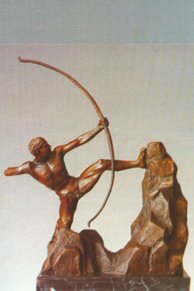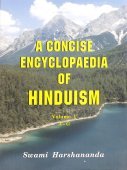Manasollasa, Mānasollāsa: 8 definitions
Introduction:
Manasollasa means something in Hinduism, Sanskrit. If you want to know the exact meaning, history, etymology or English translation of this term then check out the descriptions on this page. Add your comment or reference to a book if you want to contribute to this summary article.
In Hinduism
Dhanurveda (science of warfare)
Source: Knowledge Traditions & Practices of India: Martial Arts Traditions: A SurveyMānasollāsa (मानसोल्लास) is the name of a Sanskrit text partly dealing with the ancient Indian science of martial arts (dhanurveda).—Martial arts in India were perfected between the 6th and 11th century CE when the Gurjara-Pratihāra, a warrior dynasty, ruled much of north India. Calukyan king Someśvara III in his 11th century treatise Mānasollāsa, an encyclopaedic work in Sanskrit, gives detailed information about various types of wrestlers and their training methods.

Dhanurveda (धनुर्वेद) refers to the “knowledge of warfare” and, as an upaveda, is associated with the Ṛgveda. It contains instructions on warfare, archery and ancient Indian martial arts, dating back to the 2nd-3rd millennium BCE.
Ayurveda (science of life)
Dietetics and Culinary Art (such as household cooking)
Source: Shodhganga: Dietetics and culinary art in ancient and medieval IndiaMānasollāsa (मानसोल्लास) is written by Someśvara III. The work is also known by the name Abhilaṣitārthacintāmaṇi. This encyclopedic work is valuable as a record of the state of knowledge on many topics at that time, and draws from many older treatises on medicine, magic, veterinary science, the valuation of precious stones and pearls, fortifications, painting and music, culinary art, games and amusements and the many other subjects. It is divided into five sections (viṃśatis), each containing twenty chapters (adhyāyas). [...] In Europe the history of cookbook-writing was started only in the 13th century and in India it preceeds by a period of one hundred years. And Mānasollāsa is the first ever work on culinary art.
In the third section of Mānasollāsa, two chapters are dedicated to food. These are (annabhoga) enjoyment of food and (pānīyabhoga) enjoyment of drinking water and juices. The chapter also describes the common cooking methods such as boiling, pan frying and deep frying. A detailed account of vegetables, meats, spices, flavoring and souring agents and culinary techniques are also given in this chapter. Spices like black pepper, long pepper, ginger, cinnamon, cardamom, cumin, coriander, asafoetida and saffron are also described.
Agriculture (Krishi) and Vrikshayurveda (study of Plant life)
Source: Asian Agri-History: Drumavichitrikaranam—The Ancient Approach to Plant MutagenesisMānasollāsa (मानसोल्लास) by Someśvaradeva (1025 CE) is the name of an encyclopedic work also dealing with ancient Indian agriculture and shows that the concept of Plant Mutagenesis (druma-vichitrikaranam) was fully understood even in ancient India. Here druma means a tree and vicitrīkaraṇa means “to make (it) appear extraordinary”. Hence the term means “to make a tree appear extraordinary”. In other words, the term implies that there would be an alteration in the natural trait of the tree. Certain treatises contain a separate chapter on Plant Mutagenesis (druma-vicitrīkaraṇa), such as Someśvaradeva’s Mānasollāsa (1131 CE).
Unclassified Ayurveda definitions
Source: Research Gate: On Fish in Manasollasa (c. 1131 AD)Manasollasa or Abhilashitarthachintamani is authored by the Western Chalukya King Someshvardeva (1126–1138 AD). The text includes description of 35 kinds of marine and fresh water fishes, each with a distinct name, the feeds provided to few fishes, and the art of angling. The text also includes a brief description of cooking fish. [...] Fishes described in the text include sharks, a sawfish, a triggerfish, garfishes, carps, croakers, a spiny eel, catfishes, barbels, murrels, a ray fish, gobies, and snakeheads. Only half a dozen of these were nurtured for the royal game of angling. It is evident that considerable knowledge of fishes was gathered almost 900 years ago, but was ignored in subsequent centuries.

Āyurveda (आयुर्वेद, ayurveda) is a branch of Indian science dealing with medicine, herbalism, taxology, anatomy, surgery, alchemy and related topics. Traditional practice of Āyurveda in ancient India dates back to at least the first millenium BC. Literature is commonly written in Sanskrit using various poetic metres.
Languages of India and abroad
Sanskrit dictionary
Source: Cologne Digital Sanskrit Dictionaries: Aufrecht Catalogus Catalogorum1) Mānasollāsa (मानसोल्लास) as mentioned in Aufrecht’s Catalogus Catalogorum:—an encyclopaedia, by Bhūlokamalla Someśvaradeva (reigned 1127-38). W. p. 171. L. 1215. 2203. K. 78. Kh. 91 (2). B. 4, 252. Burnell. 141^a. Taylor. 1, 478. Oppert. 2553. Ii, 2797. 4845. 5984. 9972. Bp. 6.
Mānasollāsa has the following synonyms: Abhilaṣitārthacintāmaṇi.
2) Mānasollāsa (मानसोल्लास):—vedānta. Poona. 39. 40.
—by Kṛṣṇānanda. B. 4, 82. See Prabodhamānasollāsa.
—by Govinda. Quoted in Malamāsatattva.
—by Sureśvara. See Dakṣiṇāmūrtistotra.
3) Mānasollāsa (मानसोल्लास):—by Someśvaradeva. See Abhilashitārthacintāmaṇi.
4) Mānasollāsa (मानसोल्लास):—archit. See Jayamādhavamānasollāsa.
5) Mānasollāsa (मानसोल्लास):—[tantric] Rādh. 28. 42 (and—[commentary]). Quoted by Kaivalyāśrama Oxf. 108^a, in Āgmatattvavilāsa.
6) Mānasollāsa (मानसोल्लास):—by Someśvaradeva. Gov. Or. Libr. Madras 69. See Abhilashitārthacintāmaṇi.
7) Mānasollāsa (मानसोल्लास):—[tantric] Quoted by Narasiṃha in Tārābhaktisudhārṇava, Catal. Io. p. 898.
8) Mānasollāsa (मानसोल्लास):—by Someśvaradeva As p. 145. Bc 408.
Mānasollāsa has the following synonyms: Abhilaṣitārthacintāmaṇi.
Source: Cologne Digital Sanskrit Dictionaries: Monier-Williams Sanskrit-English DictionaryMānasollāsa (मानसोल्लास):—[from mānasa] m. Name of various works.
[Sanskrit to German]
Sanskrit, also spelled संस्कृतम् (saṃskṛtam), is an ancient language of India commonly seen as the grandmother of the Indo-European language family (even English!). Closely allied with Prakrit and Pali, Sanskrit is more exhaustive in both grammar and terms and has the most extensive collection of literature in the world, greatly surpassing its sister-languages Greek and Latin.
See also (Relevant definitions)
Starts with: Manasollasaprabandha, Manasollasavrittanta, Manasollasavrittantavilasa, Manasollasavyakhya.
Ends with: Dakshinamurtimanasollasa, Govindamanasollasa, Jayamadhavamanasollasa, Prabodhamanasollasa, Rajamanasollasa.
Full-text (+179): Manasollasavrittanta, Manasollasaprabandha, Manasollasavrittantavilasa, Manasollasavyakhya, Sri Rama Tirtha, Rajamanasollasa, Upabhogakathana, Govindamanasollasa, Prabodhamanasollasa, Varshopalagolaka, Doshaka, Vidalapaka, Katakarna, Idarika, Vatika, Veshtika, Bhandagara, Bhandari, Someshvaradeva, Shunthaka.
Relevant text
Search found 14 books and stories containing Manasollasa, Mānasollāsa; (plurals include: Manasollasas, Mānasollāsas). You can also click to the full overview containing English textual excerpts. Below are direct links for the most relevant articles:
Matangalila and Hastyayurveda (study) (by Chandrima Das)
Āpātabandha: The fourth technique < [Chapter 3]
Measurement and Age of the Elephants < [Chapter 3]
Anugatabandha: The third technique < [Chapter 3]
Cosmetics, Costumes and Ornaments in Ancient India (by Remadevi. O.)
2.6. Various other Finger Ornaments < [Chapter 3 - Ornaments]
2.19. Seasonal Clothing < [Chapter 2 - Costumes]
2.1. Pharmaceutical use of Oil < [Chapter 1 - Cosmetics]
Nitiprakasika (Critical Analysis) (by S. Anusha)
Weapons and War in Nīti works < [Chapter 1]
Asidhenu (Stiletto) < [Chapter 3]
Cakra (Discus) < [Chapter 3]
Vishnudharmottara Purana (Art and Architecture) (by Bhagyashree Sarma)
5. Preparation of Canvas before Painting < [Chapter 5 - Painting and Image Making]
Amarakoshodghatana of Kshirasvamin (study) (by A. Yamuna Devi)
Pastimes and Games < [Chapter 3 - Social Aspects]
Taittiriya Upanishad (by A. Mahadeva Sastri)
Related products
